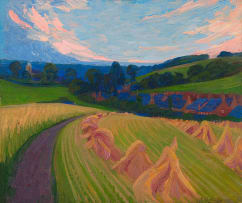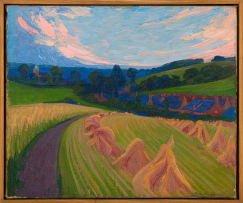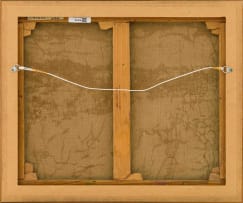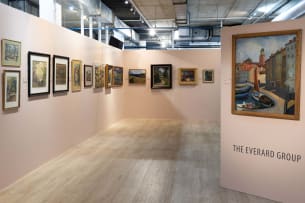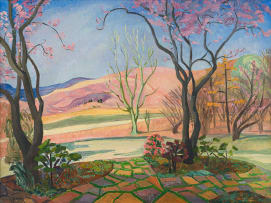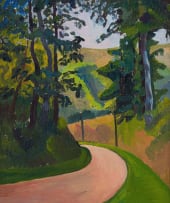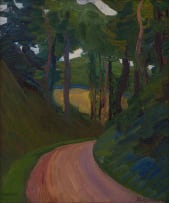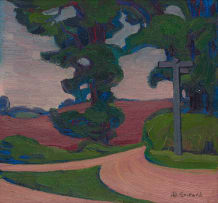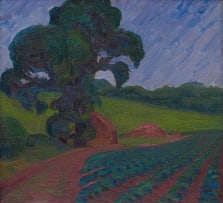The Everard Group
Timed Online Auction, 25 October - 11 November 2024
The Everard Group
About the SessionFour generations of women from one family – Edith King, her sister Bertha Everard and her two daughters Ruth and Rosamund, Ruth’s daughter Leonora, and her daughters Alana and Nichola, whose artistic production spans almost a century – this is the Everard Phenomenon. Celebrating their significant contribution to South African art history, a major national travelling exhibition of paintings by the women known as the Everard Group opened at the Grahamstown Festival in 2000. In this sale, we continue to honour this important artistic legacy as we offer a selection of artworks by almost all of the members of this remarkable family of women artists.
Edith King and her sister Bertha were the first generation of the Everard Group. Born in Natal in the 1870s, they spent their youth in England. Edith attended both London and Oxford universities, graduating in 1894. She went on to be a well-respected teacher and a prolific poet. Bertha studied music in Vienna, followed by studies at the Slade School of Fine Art, the Herkomer School of Art, and the Westminster School of Art. In 1902, after returning to South Africa, Bertha briefly joined Pretoria Girls’ High School as the art mistress. By the end of that year, she had met and married Charles Everard and moved to Bonnefoi, just north of Carolina, on the road to Machadodorp in the then Eastern Transvaal. Headstrong and competent, Bertha was instrumental in the building of the gracious family home at Bonnefoi, and in time she took on the responsibility of managing a number of farms including Lekkerdraai where the family spent many winters. In 1904 Bertha’s first daughter Ruth was born and Edith came to South Africa to assist her sister. Edith was later appointed as an art mistress at Eunice Girls’ School in Bloemfontein and subsequently as principal there.
Bertha had two further children, Rosamund and Sebastian, and Edith relocated to live at Bonnefoi to assist her sibling with her growing family responsibilities. Notwithstanding the demands of farming, the sisters continued to paint the wide-open spaces of the Eastern Transvaal landscape (now Mpumalanga). Working primarily in oils, Bertha developed a distinctively modernist ‘Everard’ style, whilst Edith worked in watercolours, using gestural brush marks and maximising the translucent qualities of the medium in her observation of nature. Despite their artistic competence, neither Bertha nor Edith was afforded the prominence in South African art history that they should have been. This may be because they lived in rural South Africa and were too far away from mainstream art production and publicity, unlike their contemporaries Irma Stern and Maggie Laubser whose success was driven by regular public exhibition and newspaper publicity.
Bertha was determined that her daughter Ruth would become a successful artist and focused much of her energy in this direction. Between 1921 and 1922, Ruth enrolled part-time at the Cape Town School of Art before moving to London to attend the Slade School of Fine Art under Henry Tonks in 1922. At the end of 1923, she moved to Paris, where she studied at the Colarossi Art School. She returned to South Africa in 1928, was married to Denholm Haden the following year and settled on a farm in Mpumalanga near Bonnefoi. Ruth frequently painted landscapes and portraiture, the influence of her years in Europe evident in her style. In the late 1950s she became a successful racehorse breeder on the farm Riverlands.
Rosamund studied music in Paris and London. She left her studies to return to South Africa and became a successful farmer. She married Nicholas Steenkamp in 1939. Rosamund had no formal art training but learned from her mother Bertha. She painted in oils with a vigour and energy, using strong and direct linear marks in strident colours, but she was also influenced by her aunt Edith’s lyrical observation of nature, and was a member of the New Group. Rosamund asserted her independence by training as a pilot and joining the South African Airforce. She died in an accident whilst flying a spitfire in England in 1946.
Leonora Everard-Haden was born in 1937. She studied Fine Arts at the University of Natal under Professor Heath, obtaining an Honours degree in 1959, followed by lithography at the Central St Martin’s School of Art in London in 1960. She returned to South Africa and became an art teacher at St Andrew’s School for Girls in Johannesburg. Like the women before her, Everard-Haden’s art comprises beautiful romantic landscapes, often depicting mountainous terrain and the extensive grasslands of Mpumalanga and the KwaZulu-Natal coast. She has also produced intimate interior vignettes, and expressive floral studies and still life paintings. Leonora married painter Derek Milton Leigh in 1964, and they had four children, including Alana and Nichola who became the fourth generation of Everard Group painters.
Nichola Alice Leigh, the younger daughter of Leonora Everard Haden and Derek Leigh, was born in Carolina in 1966. She qualified with a degree in Fine Arts from the University of Natal in 1988, and she worked briefly at the Tatham Art Gallery before becoming a full-time artist. Her works, in a variety of media including ink, pastel, watercolour and oils, celebrate nature, animals and the African landscape. She was fascinated by mountains and rocks, trees and wide -open spaces, and her style shows a distinctive Everard influence. Nichola died in 2017.
The Everard women exhibited extensively in public exhibitions throughout their artistic careers, both in England and South Africa, and their artworks are well represented in all major art collections throughout the country.
Incl. Buyer's Premium & VAT
About this Item
signed
Provenance
Acquired from the artist's family by the current owner.

